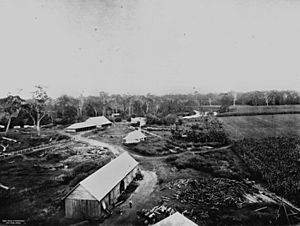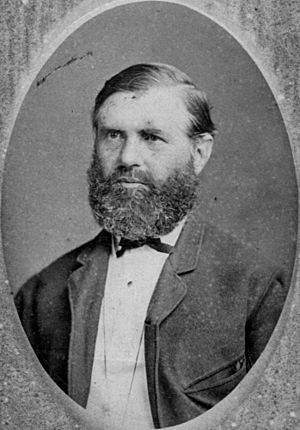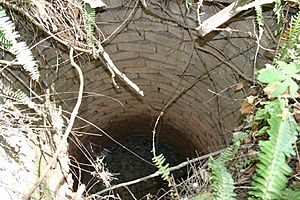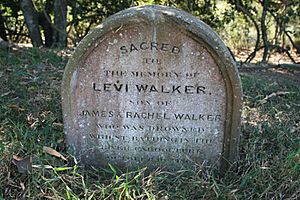Morayfield Plantation facts for kids
Quick facts for kids Morayfield Plantation |
|
|---|---|
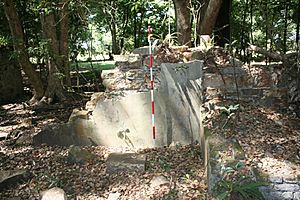
Main house foundation remnants, 2009
|
|
| Location | 34 Nolan Drive, Morayfield, Moreton Bay Region, Queensland, Australia |
| Design period | 1840s - 1860s (mid-19th century) |
| Built | c. 1860s |
| Official name: Morayfield Plantation | |
| Type | archaeological |
| Designated | 13 May 2011 |
| Reference no. | 645614 |
| Significant period | 1865-1886 |
| Significant components | building foundations/ruins, well, fence/wall - perimeter, artefact field, brick scatter/deposit, grave marker |
| Lua error in Module:Location_map at line 420: attempt to index field 'wikibase' (a nil value). | |
The Morayfield Plantation is a historic site in Morayfield, Australia. It was once a large farm where sugarcane was grown. Today, only the ruins of the plantation remain. This site is important because it shows us how sugar was made long ago. It also tells the story of the people who worked there. The plantation was added to the Queensland Heritage Register in 2011.
Contents
The Story of Morayfield Plantation
The Morayfield Plantation started in 1866. It was built on the Caboolture River, about 40 kilometers north of Brisbane. The owner was George Raff. He was a well-known businessman and politician in Queensland.
Raff supported using workers from the South Sea Islands. These workers were often called "Kanaka" at the time. They were brought to Queensland to work on sugar farms.
From 1866 to 1889, Morayfield grew sugarcane. They made sugar, rum, and molasses there. The plantation stopped growing cane around 1885-1886. George Raff died in 1889. The land was later sold in 1901 and used for dairy farming.
How the Plantation Started
In 1861, a group of settlers formed the Cabulture Cotton Company. George Raff was one of them. They wanted to grow cotton. They explored the rivers and shores of Moreton Bay to find good land.
They chose land near the Caboolture River. But growing cotton was not successful for three years. So, the company decided to sell the property.
George Raff bought a large part of the land in 1866. He bought more land nearby later. He named his new property "Morayfields," which became "Morayfield." Raff then switched from cotton to growing sugarcane.
Life and Work at the Plantation
By 1867, Raff's sugar farm was doing well. The Morayfield Plantation covered about 2,500 acres. About 150 acres were used for growing sugarcane. The main type of cane was called "Bourbon."
The plantation had many buildings. There was a large main house and a manager's house. There were also homes for married workers and their families. Other buildings included huts for laborers, stables, and workshops.
A big sugar factory was also on the site. It was close to the river and a large water reservoir. The main factory building was very large. It had a powerful steam engine to help process the sugar.
A distillery also operated there by 1867. This is where they made rum from the sugarcane. It was next to the main sugar factory.
The Plantation Railway
In 1866, Raff built a special railway. It was a narrow-gauge tramway, about 3 feet wide. This railway helped move the harvested cane from the fields to the sugar mill. It also took the finished sugar to the wharf.
Workers loaded the cane onto small railway cars by hand. Horses pulled these cars at first. By 1870, Raff used a small steam locomotive. He was one of the first in Queensland to use a train on a sugar plantation. The railway was about 2 to 3 miles long.
South Sea Islander Workers
John Dunmore Lang visited the plantation in 1868. He saw South Sea Islander laborers working there. These workers were also called "Kanaka." Many thousands of Islanders were brought to Queensland between 1863 and 1904. They worked as laborers, often under three-year contracts.
George Raff was a strong supporter of using Islander workers. He employed many of them. People believed that the climate was too hot for white laborers to do manual work. Most Islanders came from islands in Melanesia, like Vanuatu and the Solomon Islands.
Some Islanders were tricked or forced to come to Queensland. It is not clear how many Islanders worked at Morayfield. Lang noted 65 Islanders in 1868. Other reports say 15 to 20 Islanders out of about 70 total workers.
Living Conditions
Lang described the different living conditions for workers. European workers and their families lived in "comfortable brick cottages." South Sea Islander laborers lived in a large timber building. It had a corrugated iron roof.
Inside, there was a raised platform along each side for sleeping. Workers slept on blankets on the boards. They cooked their food on a fire in the middle of the building. This was similar to how they lived in their home islands.
There was also a schoolhouse on the plantation. It was also used as a church. Some Islanders attended church services there. They could read parts of the Bible in their own language.
Sometimes, Islander workers would try to leave if conditions were bad. They often did not get enough food or clothing. In 1869, 18 men from Vanuatu left Morayfield. They said Raff was not giving them enough food. They also thought their contracts had ended. A court made them return to work.
However, Lang also reported that Raff treated his Islander workers "well." They were paid 10 shillings a month plus food. Each man received a pound of beef daily. They worked until 6 PM.
Plantation Production
By the end of 1868, Morayfield Plantation had 190 acres of sugarcane. They had crushed 60 acres of cane. They had made over 18,000 gallons of rum since October 1867. They also produced 100 tons of sugar and 12,000 gallons of molasses in 1868.
Sugar continued to be made at Morayfield throughout the 1870s. Small steamships carried sugar from the plantation's wharf to Brisbane. By 1877, the estate had 60 acres of cane. The rest of the land was used for cattle and horses.
George Raff and his family did not live at the plantation all the time. They also had a home in Brisbane called "Moray Bank."
Changes Over Time
During the 1870s, many South Sea Islander workers returned home. New workers came from different islands. After 1884, laws began to limit the use of Islander laborers. People were concerned about their working conditions.
Eventually, laws were passed to stop their employment completely. By 1901, most Islanders were sent back to their home islands. Only a small number were allowed to stay in Queensland.
The plantation continued to make sugar and rum until the mid-1880s. By 1885, the distillery was not working. In 1889, it closed for good. The sugar mill was put up for sale in 1891.
George Raff died in 1889. His sons took over the plantation. The land was sold several times after that. It was mainly used for dairy farming. In 1903, people could still see traces of the old sugar mill and worker huts.
In 1960, a company bought the land to plant pine trees. Many old plantation buildings were removed then. Today, the land is being redeveloped for businesses.
What Remains Today
Even though the plantation is gone, some parts of it still remain. These ruins help us understand what the site was like. Most of the remains are in the northern part of the land, near the Caboolture River.
We can still find the steps and parts of a brick wall from Raff's main house. There are also old gardens with bamboo and palm trees. Two old wells, lined with bricks, are also on the site. One is behind the main house area.
Close to the river, there are remains of a timber yard. This was likely used for dairy farming later on. Underneath it, there are older brick surfaces. Another brick-lined well is also found nearby. This well is similar to the one near the main house.
Some parts of the old wharf can still be seen near the river. There's a large timber post and metal items like horseshoes. These items are eroding out of the river bank. This area might have many hidden artifacts from when ships loaded and unloaded goods.
A fence line made of posts and rails crosses a lagoon. This fence can be seen in old photographs from 1873. It shows us where Raff's operations were. Near this, you can find old bricks and a rusted boiler. This boiler is near where the sawmill used to be.
A slightly raised area is believed to be part of the old tramway line. This line ran from the mill to the wharf. Two metal rails, possibly from the tramway, are also hidden in a grove of bunya pines.
Levi Walker's Grave
The grave of a laborer named Levi Walker is on the river bank. He drowned in the Caboolture River on October 10, 1869. His headstone tells us he was 28 years old. It is possible there are other unmarked graves on the property.
Experts believe there could be many more hidden artifacts underground. These could include foundations of buildings and old household items. These discoveries could tell us more about daily life on the plantation. They could also show the differences in living conditions between Islander and other workers.
Why Morayfield Plantation is Important
The Morayfield Plantation is important for several reasons. It shows us one of the earliest sugar farms in Queensland. It helps us understand how the sugar industry began.
The site has important archaeological items from George Raff's time. Raff was a key figure in Queensland's early history. He played a big part in the sugar industry. He also famously used South Sea Islanders as workers.
The ruins and artifacts found here give us clues about the past. They can teach us about how sugar was grown and processed. They also tell us about the lives of the South Sea Islander people. Their stories are not always well-known.
Studying this site can help us compare it to other early sugar farms. It helps us learn about old farming methods. The wharf area can also tell us about trade and how goods moved in the region.
Few places linked to early South Sea Islander laborers still exist in Southern Queensland. This makes Morayfield Plantation a very important source of information. It helps us understand the history of forced labor in Queensland. It also helps us learn about the lives of the Islander workers, plantation owners, and managers.


